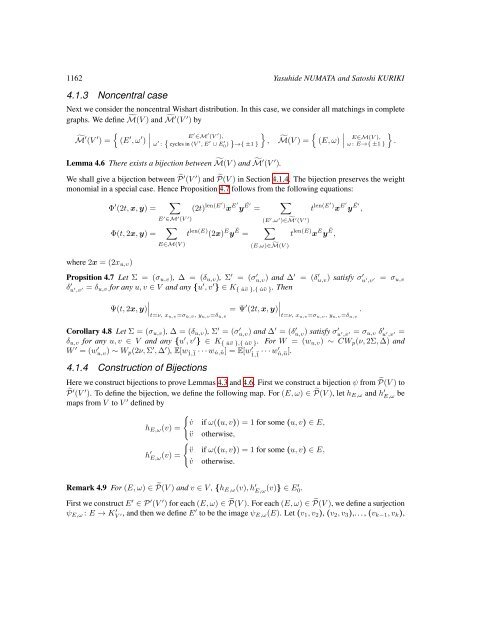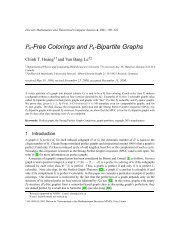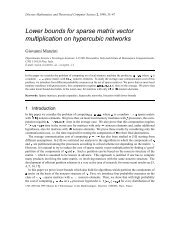On formulas for moments of the Wishart distributions as weighted ...
On formulas for moments of the Wishart distributions as weighted ...
On formulas for moments of the Wishart distributions as weighted ...
Create successful ePaper yourself
Turn your PDF publications into a flip-book with our unique Google optimized e-Paper software.
1162 Y<strong>as</strong>uhide NUMATA and Satoshi KURIKI<br />
4.1.3 Noncentral c<strong>as</strong>e<br />
Next we consider <strong>the</strong> noncentral <strong>Wishart</strong> distribution. In this c<strong>as</strong>e, we consider all matchings in complete<br />
graphs. We define ˜M(V ) and ˜M ′ (V ′ ) by<br />
˜M ′ (V ′ ) =<br />
{<br />
(E ′ , ω ′ )<br />
∣<br />
}<br />
{<br />
E ′ ∈M ′ (V ′ ),<br />
ω ′ : { cycles in (V ′ , E ′ ∪ E ′ 0 ) }→{ ±1 } , ˜M(V ) = (E, ω)<br />
Lemma 4.6 There exists a bijection between ˜M(V ) and ˜M ′ (V ′ ).<br />
∣<br />
}<br />
E∈M(V ),<br />
ω : E→{ ±1 }<br />
.<br />
We shall give a bijection between ˜P ′ (V ′ ) and ˜P(V ) in Section 4.1.4. The bijection preserves <strong>the</strong> weight<br />
monomial in a special c<strong>as</strong>e. Hence Proposition 4.7 follows from <strong>the</strong> following equations:<br />
∑<br />
∑<br />
Φ ′ (2t, x, y) = (2t) len(E′) x E′ yĚ′ =<br />
t len(E′) x E′ yĚ′ ,<br />
where 2x = (2x u,v )<br />
Φ(t, 2x, y) =<br />
E ′ ∈M ′ (V ′ )<br />
∑<br />
E∈M(V )<br />
t len(E) (2x) E yĚ =<br />
(E ′ ,ω ′ )∈ ˜M ′ (V ′ )<br />
∑<br />
(E,ω)∈ ˜M(V )<br />
t len(E) x E yĚ,<br />
Propsition 4.7 Let Σ = (σ u,v ), ∆ = (δ u,v ), Σ ′ = (σ u,v) ′ and ∆ ′ = (δ u,v) ′ satisfy σ u ′ ′ ,v = σ ′ u,v<br />
δ u ′ ′ ,v = δ ′ u,v <strong>for</strong> any u, v ∈ V and any {u ′ , v ′ } ∈ K { ˙u¨v },{ ˙u¨v } . Then<br />
Ψ(t, 2x, y) ∣ = Ψ ′ (2t, x, y) ∣ .<br />
t=ν, xu,v=σ ˙u,¨v, y u,v=δ ˙u,¨v t=ν, xu,v=σ u,v, y u,v=δ u,v<br />
Corollary 4.8 Let Σ = (σ u,v ), ∆ = (δ u,v ), Σ ′ = (σ ′ u,v) and ∆ ′ = (δ ′ u,v) satisfy σ ′ u ′ ,v ′ = σ u,v δ ′ u ′ ,v ′ =<br />
δ u,v <strong>for</strong> any u, v ∈ V and any {u ′ , v ′ } ∈ K { ˙u¨v },{ ˙u¨v } . For W = (w u,v ) ∼ CW p (ν, 2Σ, ∆) and<br />
W ′ = (w ′ u,v) ∼ W p (2ν, Σ ′ , ∆ ′ ), E[w˙1,¨1 · · · w ṅ,¨n] = E[w ′˙1,¨1 · · · w′ ṅ,¨n ].<br />
4.1.4 Construction <strong>of</strong> Bijections<br />
Here we construct bijections to prove Lemm<strong>as</strong> 4.3 and 4.6. First we construct a bijection ψ from ˜P(V ) to<br />
˜P ′ (V ′ ). To define <strong>the</strong> bijection, we define <strong>the</strong> following map. For (E, ω) ∈ ˜P(V ), let h E,ω and h ′ E,ω be<br />
maps from V to V ′ defined by<br />
{<br />
˙v if ω((u, v)) = 1 <strong>for</strong> some (u, v) ∈ E,<br />
h E,ω (v) =<br />
¨v o<strong>the</strong>rwise,<br />
{<br />
h ′ ¨v if ω((u, v)) = 1 <strong>for</strong> some (u, v) ∈ E,<br />
E,ω(v) =<br />
˙v o<strong>the</strong>rwise.<br />
Remark 4.9 For (E, ω) ∈ ˜P(V ) and v ∈ V , {h E,ω (v), h ′ E,ω (v)} ∈ E′ 0.<br />
First we construct E ′ ∈ P ′ (V ′ ) <strong>for</strong> each (E, ω) ∈ ˜P(V ). For each (E, ω) ∈ ˜P(V ), we define a surjection<br />
ψ E,ω : E → K ′ V ′, and <strong>the</strong>n we define E′ to be <strong>the</strong> image ψ E,ω (E). Let (v 1 , v 2 ), (v 2 , v 3 ),. . . , (v k−1 , v k ),






